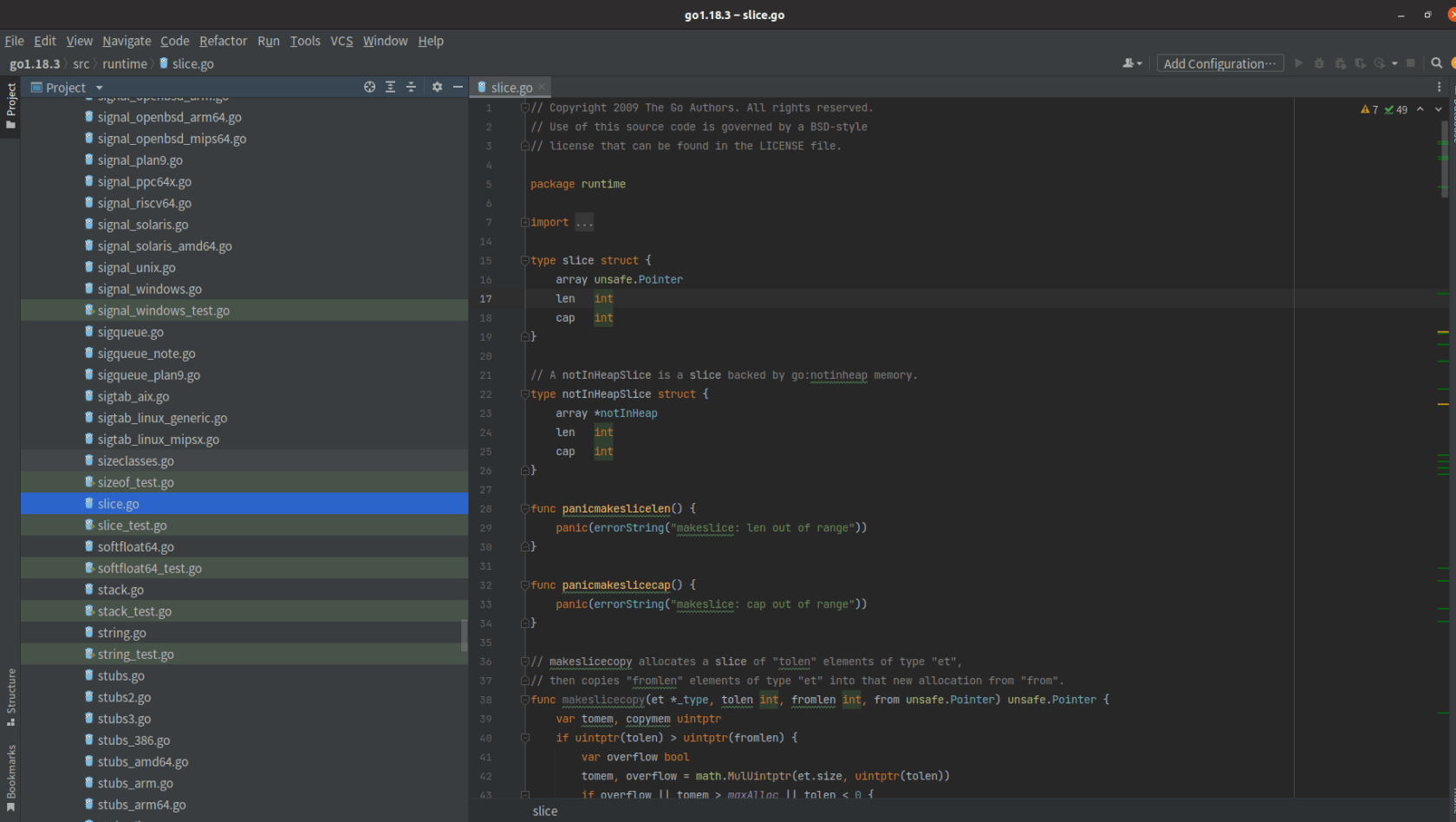10分钟带你搞定slice底层原理!
本篇整理的内容是基于go 1.18 版本。
前言
在工作中,slice一定是你用的最多的数据类型之一。本篇文章来带你快速了解slice的底层原理。
首先,slice的代码存放在/src/runtime/slice.go 文件中。
底层结构
type slice struct {
array unsafe.Pointer
len int
cap int
}slice一共有3个字段。其中,array代表底层数组的指针,len 代表 slice的长度,cap代表slice的长度,也是底层数组的长度。
在创建slice时,容量和长度是相等的。例如,创建一个长度为5的切片,那么它的容量也是5。
扩容机制
我们知道,数组的长度不可变化的。当调用append时,如果append后的长度超过slice的容量(底层数组的长度),就会发生扩容。
发生扩容后,底层数组会被替换,那么新底层数组的长度又是多少呢?
来,直接贴源码。
newcap := old.cap
doublecap := newcap + newcap
if cap > doublecap {
newcap = cap
} else {
const threshold = 256
if old.cap < threshold {
newcap = doublecap
} else {
// Check 0 < newcap to detect overflow
// and prevent an infinite loop.
for 0 < newcap && newcap < cap {
// Transition from growing 2x for small slices
// to growing 1.25x for large slices. This formula
// gives a smooth-ish transition between the two.
newcap += (newcap + 3*threshold) / 4
}
// Set newcap to the requested cap when
// the newcap calculation overflowed.
if newcap <= 0 {
newcap = cap
}
}
}
var overflow bool
var lenmem, newlenmem, capmem uintptr
// Specialize for common values of et.size.
// For 1 we don't need any division/multiplication.
// For goarch.PtrSize, compiler will optimize division/multiplication into a shift by a constant.
// For powers of 2, use a variable shift.
switch {
case et.size == 1:
lenmem = uintptr(old.len)
newlenmem = uintptr(cap)
capmem = roundupsize(uintptr(newcap))
overflow = uintptr(newcap) > maxAlloc
newcap = int(capmem)
case et.size == goarch.PtrSize:
lenmem = uintptr(old.len) * goarch.PtrSize
newlenmem = uintptr(cap) * goarch.PtrSize
capmem = roundupsize(uintptr(newcap) * goarch.PtrSize)
overflow = uintptr(newcap) > maxAlloc/goarch.PtrSize
newcap = int(capmem / goarch.PtrSize)
case isPowerOfTwo(et.size):
var shift uintptr
if goarch.PtrSize == 8 {
// Mask shift for better code generation.
shift = uintptr(sys.Ctz64(uint64(et.size))) & 63
} else {
shift = uintptr(sys.Ctz32(uint32(et.size))) & 31
}
lenmem = uintptr(old.len) << shift
newlenmem = uintptr(cap) << shift
capmem = roundupsize(uintptr(newcap) << shift)
overflow = uintptr(newcap) > (maxAlloc >> shift)
newcap = int(capmem >> shift)
default:
lenmem = uintptr(old.len) * et.size
newlenmem = uintptr(cap) * et.size
capmem, overflow = math.MulUintptr(et.size, uintptr(newcap))
capmem = roundupsize(capmem)
newcap = int(capmem / et.size)
}有兴趣的同学,可以看下源码。我直接把结论打上了。
- 如果新申请长度大于 2 倍的旧容量,那么最终容量就是新的切片长度 。
- 如果旧容量小于256,那么最终容量就是旧容量的两倍 。
- 如果旧容量大于256,最终容量不一定是多少,因为涉及到移位。(大概是之前容量的1.25倍)
- 如果最终容量计算值溢出,则最终容量就是新的切片长度。
注意,我们只需知晓扩容的原理即可,不必纠结扩容后具体的数字。
思考题
留一道思考题,如果这道题答对了,说明你对go的指针、切片掌握的很不错哦~
func main() {
a := []int{1,2,3}
slice(a)
fmt.Println("1", a)
slicePtr1(&a)2
fmt.Println("2", a)
slicePtr2(&a)
fmt.Println("3", a)
slicePtr3(&a)
}
func slice(s []int) {
s[0] = 10
s = append(s, 10)
s[1] = 10
}
func slicePtr1(s *[]int) {
(*s)[0] = 20
*s = append(*s, 20)
(*s)[1] = 20
}
func slicePtr2(s *[]int) {
b := *s
b[0] = 30
b = append(b, 30)
b[1] = 30
}
func slicePtr3(s *[]int) {
b := *s
b = append(b, 40)
fmt.Println("4", b)
*s = append(*s, 50)
fmt.Println("5", b)
}
//请问最后会打印出什么?题目答案我将会在评论区公布~
最后
最后,放一下我的个人知识库,有兴趣的同学可以关注一下~
www.yuque.com/shier-zone
本作品采用《CC 协议》,转载必须注明作者和本文链接



 关于 LearnKu
关于 LearnKu




推荐文章: